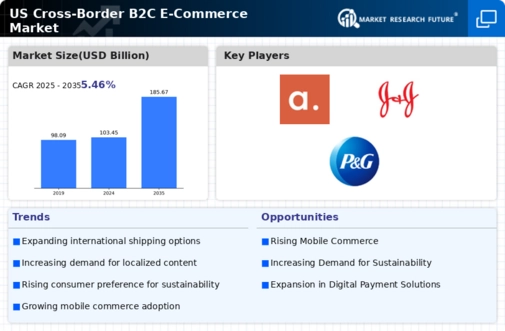Expansion of Online Marketplaces
The proliferation of online marketplaces is a pivotal driver in the cross border-b2c-e-commerce market. Major platforms such as Amazon and eBay are expanding their international reach, allowing US consumers to access products from various countries. In 2025, it is projected that cross border sales through these platforms will increase by approximately 30%. This expansion not only provides consumers with a wider array of products but also offers sellers the opportunity to tap into new markets. The competitive pricing and diverse product offerings available on these platforms are likely to attract more consumers, thereby propelling growth in the cross border-b2c-e-commerce market.
Regulatory Changes and Trade Agreements
Regulatory changes and new trade agreements are shaping the landscape of the cross border-b2c-e-commerce market. Recent developments in trade policies are facilitating easier access to international markets for US businesses. In 2025, it is projected that favorable trade agreements will lead to a 15% increase in cross border e-commerce transactions. These agreements often reduce tariffs and simplify customs procedures, making it more feasible for businesses to engage in international trade. As regulations become more conducive to cross border transactions, the cross border-b2c-e-commerce market is likely to experience accelerated growth, benefiting both consumers and businesses.
Improved Logistics and Shipping Solutions
The evolution of logistics and shipping solutions is a crucial factor propelling the cross border-b2c-e-commerce market. Companies are investing in advanced logistics technologies, such as AI and machine learning, to optimize supply chain operations. In 2025, it is expected that the efficiency of cross border shipping will improve, with delivery times decreasing by up to 20%. Enhanced tracking systems and partnerships with local carriers are also being established to ensure timely deliveries. These improvements not only enhance customer satisfaction but also reduce operational costs for businesses, making the cross border-b2c-e-commerce market more attractive for both consumers and sellers.
Rising Consumer Demand for Unique Products
There is a notable increase in consumer demand for unique and niche products, which is significantly influencing the cross border-b2c-e-commerce market. US consumers are increasingly seeking products that are not readily available domestically, driving them to explore international options. This trend is particularly evident in categories such as fashion, beauty, and home decor. In 2025, it is anticipated that the demand for unique products will contribute to a 25% increase in cross border transactions. As consumers become more adventurous in their purchasing habits, businesses that cater to these preferences are likely to thrive, further stimulating the cross border-b2c-e-commerce market.
Technological Advancements in Payment Solutions
The cross border-b2c-e-commerce market is experiencing a surge in technological advancements, particularly in payment solutions. Innovations such as digital wallets, blockchain technology, and instant payment systems are enhancing transaction efficiency. In 2025, it is estimated that mobile payment transactions will account for over 50% of all e-commerce transactions in the US. This shift not only simplifies the purchasing process for consumers but also reduces transaction costs for businesses. Enhanced security measures, including biometric authentication, are also being integrated, fostering consumer trust. As these technologies evolve, they are likely to drive growth in the cross border-b2c-e-commerce market, enabling seamless transactions across borders and enhancing the overall shopping experience.














Leave a Comment